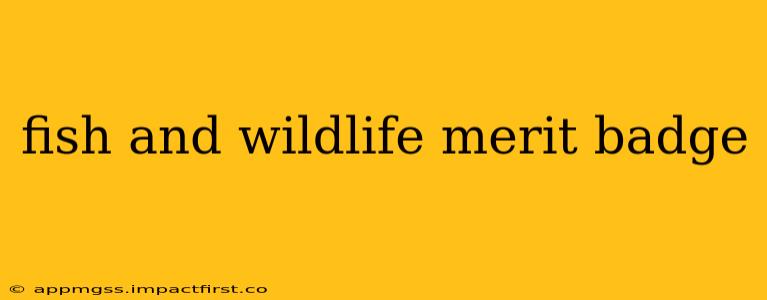The Fish and Wildlife merit badge is a popular choice among Scouts, offering a fascinating journey into the world of conservation and responsible outdoor stewardship. This guide delves into the requirements, providing detailed information and insights to help you earn this prestigious badge. We'll cover everything from identifying wildlife to understanding conservation efforts, ensuring you're well-prepared for your merit badge counselor.
Understanding the Requirements
Before we dive into the specifics, let's review the general requirements for the Fish and Wildlife merit badge. While the exact requirements may vary slightly depending on your council, the core elements consistently revolve around:
- Identifying local wildlife: This includes both fish and wildlife species found in your region.
- Understanding wildlife habitats: Knowing the needs of different species and how their environments impact their survival.
- Conservation practices: Learning about responsible fishing, hunting, and overall wildlife conservation.
- Wildlife management: Grasping the principles and techniques used to manage fish and wildlife populations.
What are the different types of fish and wildlife habitats?
Different fish and wildlife species require specific habitats to thrive. Understanding these habitats is crucial for conservation efforts. We can categorize them broadly:
-
Aquatic Habitats: These include rivers, lakes, streams, ponds, oceans, and estuaries. Each body of water has unique characteristics affecting the types of fish that can live there. Factors like water temperature, oxygen levels, and salinity play vital roles.
-
Terrestrial Habitats: These encompass forests, grasslands, deserts, mountains, and wetlands. Each habitat type supports a unique array of wildlife, shaped by factors such as vegetation, climate, and topography. For instance, a desert tortoise will need different conditions than a moose.
-
Transitional Habitats: These areas lie between aquatic and terrestrial environments, such as marshes, swamps, and mangroves. These areas are incredibly biodiverse, supporting a wide range of species adapted to both land and water.
How can I identify local fish and wildlife?
Identifying local species is a fundamental part of this merit badge. Here's how you can approach it:
-
Field Guides: Invest in a good field guide specific to your region. These guides contain detailed descriptions, illustrations, and photographs to aid identification.
-
Online Resources: Websites like iNaturalist and Merlin Bird ID offer valuable tools for identifying species based on images or descriptions.
-
Expert Guidance: Seek help from local naturalists, park rangers, or experienced outdoorsmen who can guide you in your identification efforts. Your merit badge counselor can be an invaluable resource here.
-
Learn key characteristics: Focus on distinguishing features like size, coloration, markings, and behavior to accurately identify different species.
What are some common conservation practices?
Conservation is paramount in responsible fish and wildlife management. Some key conservation practices include:
-
Sustainable Fishing Practices: Understanding catch limits, using barbless hooks, and practicing catch-and-release techniques for certain species.
-
Responsible Hunting Practices: Following hunting regulations, using ethical hunting methods, and respecting wildlife.
-
Habitat Preservation: Supporting efforts to protect and restore crucial habitats for fish and wildlife.
-
Pollution Control: Reducing pollution that harms aquatic and terrestrial ecosystems.
-
Wildlife Rehabilitation: Supporting local wildlife rehabilitation centers to help injured or orphaned animals.
What are the roles of fish and wildlife management?
Effective fish and wildlife management aims to maintain healthy populations and thriving ecosystems. This involves:
-
Population Monitoring: Tracking the numbers and health of different species to assess their status.
-
Habitat Management: Implementing practices to improve and protect habitats, ensuring suitable conditions for wildlife.
-
Controlling Invasive Species: Managing invasive species that threaten native populations.
-
Public Education and Outreach: Educating the public about conservation and responsible practices.
-
Enforcement of Regulations: Ensuring compliance with regulations to protect wildlife and their habitats.
This guide provides a solid foundation for your Fish and Wildlife merit badge journey. Remember to consult your merit badge counselor for specific requirements and guidance throughout the process. The more you immerse yourself in the world of fish and wildlife, the more rewarding this experience will become. Good luck earning your badge!
